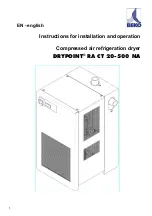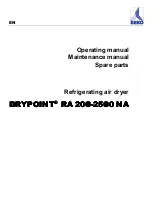
Page 6
506746−01 05/12
Installing the air proving switch (included)
IMPORTANT − Failure to install the air proving switch
will void the humidifier warranty!
The air proving switch (Cat. no. Y3786; provided with hu-
midifier) is a differential pressure switch that is required to
make sure that the blower is running prior to steam produc-
tion. Six feet of 3/16" tubing is provided along with two
pressure taps (mounting screws are not included) to con-
nect both pressure taps to the switch, however, install the
switch first, and then install one pressure tap in only the
supply duct (positive pressure application, step 2. below).
See figure 6.
1.
Install switch and pressure tap
Select a mounting location near the supply duct which
will not be subject to vibration or where the switch
could be damaged. Mount the air proving switch in any
vertical plane except with the tubing connections di-
rected upward.
Connect the normally open terminals on the air proving
switch to the low voltage terminal strip in the humidifi-
er. See wiring diagrams in figures 13 through 17.
2.
Positive pressure application
Use the positive
pressure application when large amounts of air flow or
high static is present at the pressure tap in the supply
duct.
Install the duct air sampling tap to the supply duct work
as close to the switch as possible on the positive side
of the blower (see figure 6).
From the 6’ tubing provided, cut just enough 3/16" tub-
ing to reach from the pressure tap to the P1 switch
port. (P2 remains open).
NOTE − Check for closure of the blower switch using
the lowest blower speed setting. If the switch fails to
close the open set of contacts, you must use the differ-
ential application.
3.
Differential pressure application
Use the differen-
tial pressure application when small amounts of air
flow or low static is present across the pressure tap.
Install the 2nd pressure tap in the return duct work (see
figure 6).
Use the remaining 3/16" tubing to connect P2 switch
port to the negative pressure tap. Check for closure of
the switch when blower is turned on.
Plumbing
Water characteristic requirements
The humidifier must be supplied with water with the
following characteristics:
S
Pressure between 20 psi and 110 psi (0.137 MPa and
0.758 MPa; [1.4 and 7.6 bar])
S
Temperature between 33º F and 104º F (1ºC and
40ºC)
S
Flow−rate minimum of 0.21 gpm (0.45 L/m)
S
Hardness no greater than 400 ppm
3
of CaCO (40º fH)
S
Conductivity from 125 to 1250
μ
S/cm
S
Absence of organic compounds
S
The characteristics of the water supply must fall within
the following limits:
MPa = Megapascals
fH = French degrees of hardness
μ
S/cm = microsiemens per centimeter
Unacceptable water types:
S
Softened Water
as this will lead to foam, electrode
corrosion and greatly shortened cylinder life.
S
Water containing disinfectants or corrosion inhibiters,
as these are potential irritants.
S
Industrial water, boiler water or water from cooling cir-
cuits.
S
Any potentially chemically or bacteriologically
contaminated water.
S
Heated water.
Testing Water
A conductivity
meter is
recommended for
testing the water: Cat # Y3480 (AP−2 AquaPro Water
Quality Tester). Specifications:
EC Range: 0−9999
μ
S.
Temperature Range: 0−80
°
C; 32−176
°
F.
Resolution: 1
μ
S; Temp. resolution is 0.1
°
C/F.
Accuracy: +/− 2%
Calibration: Digital calibration by push button.
Housing: Water−resistant.
Power source: 1 x 3V button cell (included) (model
CR2032).
Dimensions: 15 x 2.8 x 1.3 cm (5.9 x 1.1 x .5 inches) .
Weight: 42.5 g (1.5 oz.).
Water supply connection
The recommended connection between the fill valve and
the water supply line is by way of the provided fill hose (5’
[1.5 m] hose with one straight 3/4" fitting and one 90 de-
gree 3/4" fitting). The provided hose absorbs water "ham-
mering" in order to avoid fill valve damage.
The water line may be routed through the back or through
the bottom of the unit. The fitting then threads onto the
valve assembly inlet located on the bottom of the humidifi-
er (see figure 6) using a 3/4" female garden hose connec-
tion. Note that there is a strainer built into the fill valve fitting
underneath the unit, which will require periodic cleaning,
so be sure to allow clearance for access.







































